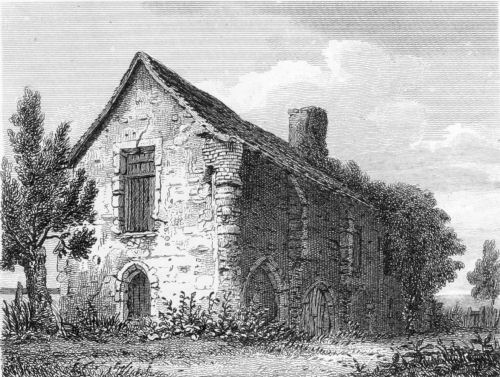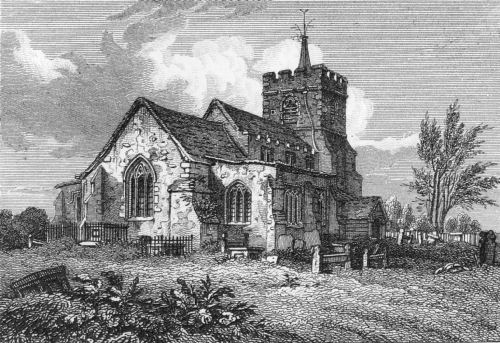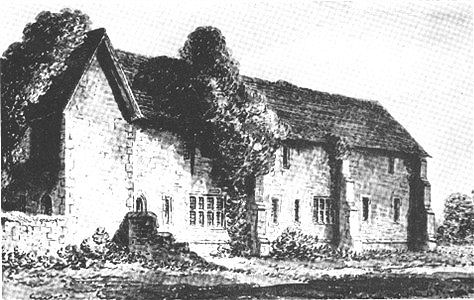|
Kings Langley in the early 19th century |
|
|
Kings Langley in the early 19th century |
|
 |
From Remains of an Ancient Palace, Kings Langley Herts Engraved by I. Greig from a Drawing by F. W. L. Stockdale for the Antiquarian Itinerary Published for the Proprietors March. 1. 1818 by W. Clarke, New Bond St.
|
|
Three miles south-east of Hemel Hempsted, upon the banks of the little river Bulbourne, is the small irregular village of KING'S LANGLEY, which, notwithstanding its present insignificance, was formerly a place of royal residence, having being able to boast of a palace erected here by Henry III. and in which Edmund of Langley, Edward the Third's fifth son, was born. Of this once magnificent structure, however, but few vestiges can be now traced: a farm house, of no very prepossessing aspect, occupies part of its site. The estate belonging to it is now the property of Mary, the daughter and heiress of Mr. Thomas King; and is held on lease under her by a respectable brewer, who lives in the village. Here was formerly a Dominican priory founded in the beginning of the 13th century, and afterwards richly endowed; especially by the munificence of Edward l. who granted the manor of Langley to it. Its annual revenues at the period of the Dissolution amounted to 1501. 14s. 8d. as Speed informs us. The parish Church is a neat structure upon the left, having at its western extremity a large embattled tower. This church consists of a nave, chancel, and aisles, and contains many ancient monuments.
|
 |
From Kings Langley Church, Herts Engraved by W. Wallis from a Drawing by F. W. L. Stockdale for the Antiquarian Itiny Published for the Proprietors Feb. 1. 1818 by W. Clarke, New Bond St.
|
|
The Church consists of a nave, chancel, and aisles, with a massive embattled tower at the west end, which was originally open to the nave by a pointed arch, rising from clustered columns. About the middle is another large pointed arch, dividing the nave and chancel, which are separated from the aisles by five plain pointed arches on each side, mostly supported on octagonal columns; but varied on the north by clustered columns. The east window consists of three lights; the centre light terminates in a trefoil, the others in quatrefoils. The windows of the nave are small, and of a square form, though divided into trefoil-headed lights. Among the ancient monuments in this edifice, is a very large altar-tomb of free-stone, in the east angle of the north aisle, having recumbent, but greatly mutilated, effigies of a Knight and a Lady: the latter on the right hand. The Knight is in armour, with a shirt of chain-work: his hands folded across his body, as in prayer. On his left breast is a crescent; and on each shoulder, his arms, on a cross, five mullets, with a crescent for difference: the legs and thighs are broken off, and gone; and the head is loose, and much defaced. The Lady has on a flowered robe, and over it a long cloak, fastened across the neck, from which is pendant a chain, and small cross. On her left side is a crescent; and on her right, a saltire engrailed; below which, on the folds of the cloak, are the same arms as on the Knight's shoulder. The hands, which have been raised as in prayer, are broken off and the countenance is much defaced. The head-dress is of an angular form, of the time of Henry the Seventh. On the west and south aisles of the tomb, are shields of the above arms, in square compartments, with trefoils in the angles: on one of the shields, the arms are impaled. This is probably the tomb of SIR JOHN VERNEY, of Pendley; who was Sheriff of Herts and Essex in the fourteenth of Henry the Seventh. Salmon seems to intimate that this was the tomb of Piers Gaveston, the haughty favorite of Edward the Second; but the arms are those of Verney. Gaveston, as appears from Stowe, was first buried among the Friars Preachers at Ox ford; but two years afterwards, his body was removed by the King with great pomp, and re-interred in this Church. Within the altar-rails, on the north side, is the tomb of EDMOND OF LANGLEY, son of Edward the Third, who was buried here, near the remains of his first wife, ISABEL, younger daughter of Pedro, King of Castile. This tomb was originally differently situated, as appears from its sides being surrounded with shields of arms; though, from its present position, those only on the west and south can now be seen. The arms on the west side, are those of Westminster, England, and Mercia: the shields on the south, display the arms of Edmond, &c. All the shields are in the centres of ornamented square compartments: below them, under plain mouldings, is a range of quatrefoils, apparently surrounding the whole tomb. The top is now covered with a broken slab of Purbeck marble; the other parts are of free-stone. Opposite to the above, on the south side of the altar, is a plain tomb of white marble; over which is a tablet, in memory of the HONORABLE WILLIAM GLASCOCKS, of Adamhowe, in Essex, who was Judge of the Admiralty in Ireland in the time of Charles the Second: he died in July, 1688, at the age of seventy-three. Several slabs, with Brasses, are yet remaining here: one of them, in the north aisle, has small, but neat figures of a male in a long cloak; and two females, with large hats and ruffs, of the time of Elizabeth. Below them, and over two smaller brasses, containing groups of children, nine in each, is this inscription:
On another slab, close to the former, is a small Brass of a female, with an indent for a male figure, which is now gone: the inscripion records the name William Carter and Alys his wife, the former died the eleventh of April, 1528. Some fragments of painted glass, with the arms of Sanky, Dalarnar, &c. remain in a window of the north aisle. The Church-yard is extensive, and contains many tombs and sepulchral memorials: the most remarkable of these is within a space inclosed by iron rails, at the end of the south aisle. It displays an elegant sarcophagus, having a circle in front, surrounding a section of a Saxon building, with the motto, Stabilior Amicitia: above this, on a circular marble tablet, is a basrelief of an infant Hymen, weeping, his torch inverted. This was executed in memory of MRS. ELIZABETH CRAWFORD, of King's Langley, who died in April, 1793, at the age of forty-two.
from |

King's Langley Priory, from
The
History of Kings Langley
Page created December 2009